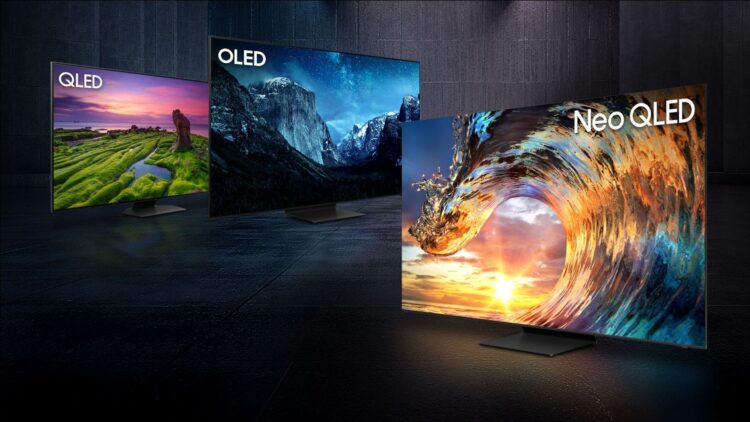If you’re in the market for a new TV, you may find it difficult to decide between QLED and OLED technologies. While these two types of TVs may sound similar, they work in very different ways that lead to different results in color, contrast, and brightness.
What makes the choice even more difficult is that both technologies are known for delivering excellent picture quality. The trick is to find out which one is better suited to your viewing needs, and that means understanding the key differences between the two.
In this article, we’ll give you the basics of how QLED and OLED TVs work and explore where each type of TV shines so you can make a more informed decision.
QLED and OLED: Bright lights and bold colors
QLED is short for quantum dot light-emitting diode, as it is powered by minuscule particles known as quantum dots which enhance the brightness and color of the image. These dots are utilized on a classic LCD screen, enhancing color accuracy and brightness when compared to regular LED televisions. If you frequently watch TV during daylight hours or have a brightly lit living space, QLED technology is a great choice due to its capacity to produce vivid images even in well-lit settings.
Because QLED TVs continue to rely on a backlight, they are unable to match the deep blacks produced by OLED panels. Nevertheless, their deficiency in black levels is compensated for by their impressive brightness. You can watch a show in a bright room without needing to squint.
- Burn-in prevention: QLED TVs are less likely to suffer from burn-in, which is good news if you watch channels with static images or play video games for long hours.
- Brightness advantage: When it comes to peak brightness, QLED TVs shine brightest, literally. Their ability to stay clear in high ambient light makes them perfect for brightly lit rooms.
- Color brilliance: Quantum dots help QLED TVs maintain color accuracy and saturation, even when brightness is dialed up.
QLED and OLED: The deep black difference
OLED provides self-lighting pixels, a feature that QLED lacks. Every individual pixel on an OLED TV can illuminate independently, eliminating the necessity for a distinct backlight. This indicates that when a pixel is deactivated, it is completely inactive, resulting in a deep black that cannot be replicated by any other technology.
This characteristic makes OLED screens stand out for their superior contrast, producing rich colors and dark blacks that shine in dim environments. If you enjoy watching movies at home in a theater-like environment and are a fan of movies, OLED could be the perfect choice for you.
Although OLED panels are celebrated for their impressive picture quality, they also pose risks like burn-in, particularly when static images are shown for extended durations.
- Stunning visuals: The picture quality of OLED TVs is nearly unmatched, with impressive contrast, vibrant colors, and an overall immersive visual experience.
- Thin design: OLED panels are much slimmer since they don’t need a separate backlight, giving them a sleek profile that can easily fit into any modern home setup.
- Wide viewing angles: With OLED, it doesn’t matter where you sit in the room — the picture remains sharp from nearly every angle.
Which picture is right for you?
When it comes to deciding between QLED and OLED, it all depends on your needs. OLED’s deep blacks and superior contrast make it perfect for watching movies in darker rooms. On the other hand, QLED’s bright, colorful display is a great fit for well-lit rooms and can handle lots of daylight without losing quality.
If you’re a fan of gaming, QLED’s resistance to burn-in and vibrant visuals may appeal more to you. OLED, while producing stunning cinematic pictures, does come with that burn-in risk, though it’s less likely in newer models.
Other factors to keep in mind
Picture quality might be the main concern for most buyers, but it’s not the only consideration when comparing QLED and OLED TVs. Durability, future-proofing, and price are all factors that could sway your decision.
- Durability: While OLED provides incredible visuals, it is more prone to burn-in and image retention, particularly when static content is displayed for long periods. QLED doesn’t have this issue, making it more durable in that sense.
- Innovation: Both QLED and OLED are rapidly evolving technologies, and newer advancements like mini LED and QD-OLED are already pushing the boundaries of what these displays can do.
- Price point: Generally, OLED TVs are more expensive due to the complexity of manufacturing the organic materials they use, while QLED models tend to be more affordable.
Ultimately, both QLED and OLED TVs have their strengths, and which one you choose depends on your specific needs. Whether it’s the brightness of QLED or the deep blacks of OLED that win you over, you’re bound to get a stunning visual experience from either. You can also check OLED TVs at Martin Dawes for comparison and purchasing.
Image credits: Samsung





